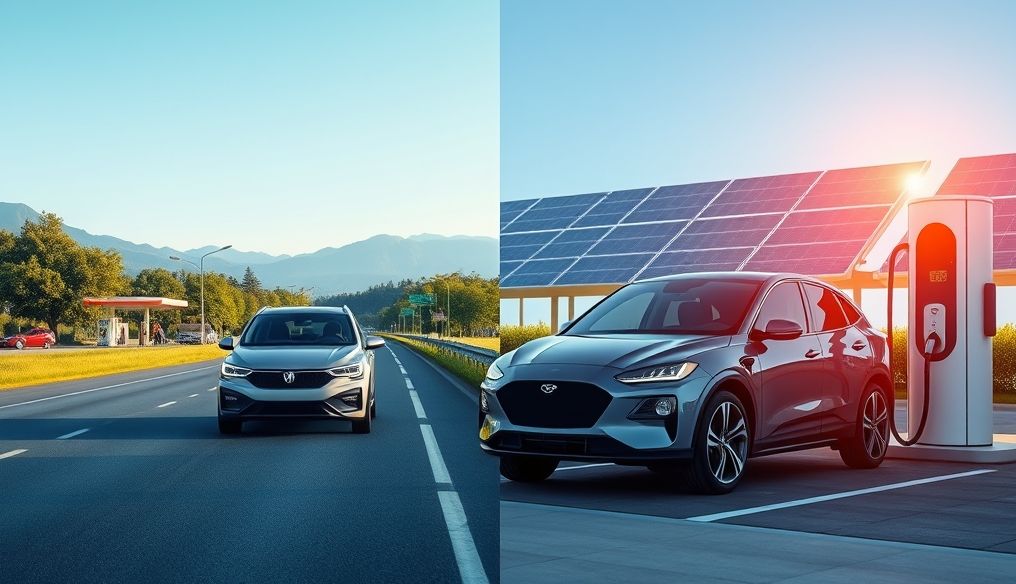What's the Difference Between Hybrid and Fully Electric Cars, and Which is Right for You?
With increasing environmental awareness and rising fuel prices, environmentally friendly cars are becoming an attractive option for many. Among these options, hybrid cars and fully electric vehicles (EVs) stand out as promising alternatives. But what is the fundamental difference between them? And which is best suited for your lifestyle and needs? This article will provide you with a comprehensive and detailed comparison to help you make the right decision.
Chapter 1: Basics of Hybrid Cars
What is a Hybrid Car?
A hybrid car is a vehicle that uses a combination of a traditional internal combustion engine (powered by gasoline or diesel) and an electric motor. The electric motor supports the traditional engine, reducing fuel consumption and harmful emissions.
Types of Hybrid Cars:
- Mild Hybrids: Primarily use the electric motor to assist in starting and providing extra power to the traditional engine. They cannot move relying solely on electric power.
- Full Hybrids: Can move relying solely on electric power for short distances and at low speeds. They can recharge the battery while driving through a regenerative braking system.
- Plug-in Hybrids (PHEVs): Feature a larger battery that can be charged from an external source (such as a household electrical outlet or public charging station). They can move relying on electric power for longer distances than full hybrids.
Advantages of Hybrid Cars:
- Fuel Efficiency: Consume less fuel than traditional cars, saving money in the long run.
- Reduced Emissions: Produce fewer greenhouse gas emissions, contributing to environmental conservation.
- Improved Performance: The electric motor provides extra power, improving the car's acceleration and performance.
- Longer Driving Range: Do not depend on the charging infrastructure for electric cars, as they can rely on traditional gas stations.
Disadvantages of Hybrid Cars:
- Higher Initial Cost: Usually more expensive than similar traditional cars.
- Complex Maintenance: Require maintenance for both engines (internal combustion and electric), which may increase maintenance costs.
- Heavier Weight: Contain a battery and additional components, increasing the car's weight and affecting its performance.
Chapter 2: Basics of Fully Electric Cars
What is a Fully Electric Car?
A fully electric car is a vehicle that runs only on electricity. It does not have an internal combustion engine and relies entirely on a large battery to store energy and power the electric motor.
Advantages of Fully Electric Cars:
- Zero Emissions: Produce no harmful emissions while driving, making them highly environmentally friendly.
- Low Running Costs: Electricity is cheaper than gasoline or diesel, reducing fuel costs.
- Less Maintenance: Contain fewer moving parts compared to traditional cars, reducing maintenance costs.
- Excellent Performance: Provide fast acceleration and instant torque, making them fun to drive.
- Government Incentives: In many countries, governments offer tax incentives and subsidies to purchase electric cars.
Disadvantages of Fully Electric Cars:
- Limited Driving Range: Depends on battery capacity, and the driving range may be limited compared to traditional cars.
- Charging Time: Charging the battery takes longer than filling up a fuel tank.
- Charging Infrastructure: The infrastructure of public charging stations is still under development in many areas.
- High Initial Cost: Usually more expensive than similar traditional cars.
- Battery Degradation: Battery capacity may degrade over time, reducing the driving range.
Chapter 3: Direct Comparison Between Hybrid and Fully Electric Cars
| Feature | Hybrid Cars | Fully Electric Cars |
|---|---|---|
| Power Source | Internal combustion engine + electric motor | Electric motor only |
| Emissions | Fewer emissions than traditional cars | Zero emissions while driving |
| Fuel Efficiency | Good fuel saving | No fuel needed (runs on electricity) |
| Driving Range | Long driving range | Limited driving range (depends on battery capacity) |
| Charging/Refueling Time | Fast refueling | Longer charging time |
| Infrastructure | Relies on traditional gas stations | Relies on electric charging stations |
| Initial Cost | Higher than traditional cars | Higher than traditional and hybrid cars mostly |
| Running Costs | Lower than traditional cars | Lower running costs (electricity is cheaper than fuel) |
| Maintenance | Complex maintenance (two engines) | Less complex maintenance |
Chapter 4: Factors Influencing the Choice of the Right Car
Driving Style:
If you drive long distances frequently, a hybrid car may be a better option due to the longer driving range. But if most of your driving is within the city for short distances, a fully electric car may be suitable.
Charging Infrastructure:
If you live in an area where public charging stations are readily available, an electric car may be a practical option. But if the charging infrastructure is limited, a hybrid car may be more convenient.
Budget:
The initial cost is an important factor. Electric and hybrid cars are usually more expensive than traditional cars, but you should also consider the running and maintenance costs in the long run.
Environmental Concerns:
If you pay great attention to the environment and want to minimize your carbon footprint, a fully electric car is the best option.
Chapter 5: The Future of Hybrid and Electric Cars
The automotive market is witnessing rapid developments in the field of hybrid and electric cars. Battery technologies are constantly evolving, increasing driving range and reducing charging time. Also, the infrastructure of charging stations is expanding rapidly worldwide. Electric and hybrid cars are expected to become more widespread and affordable in the near future.
Chapter 6: Tips for Buying a Hybrid or Electric Car
- Research well: Compare different models, specifications, and prices.
- Test drive: Test drive the car before buying to evaluate its performance and suitability for your needs.
- Check government incentives: Find out about the tax incentives and subsidies available in your country or region.
- Consider home charging: If you are considering buying an electric car, invest in a home charger to facilitate the charging process.
- Check the battery warranty: Make sure the battery is covered by a good warranty.
Chapter 7: The Impact of Hybrid and Electric Cars on the Environment
Hybrid and electric cars play an important role in reducing air pollution and reducing greenhouse gas emissions. These cars contribute to improving air quality in cities and reducing dependence on fossil fuels, which helps in combating climate change.
Chapter 8: Conclusion: Which One to Choose?
Choosing the right car (hybrid or electric) depends on a variety of factors, including driving style, budget, environmental concerns, and the availability of charging infrastructure. There is no one-size-fits-all answer, but by understanding the differences between hybrid and fully electric cars, you can make an informed decision that suits your needs and priorities.
"In 2022, electric car sales rose by 55% globally, to reach over 10 million." - International Energy Agency (IEA)




